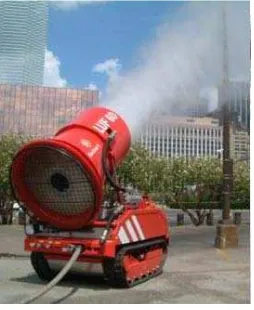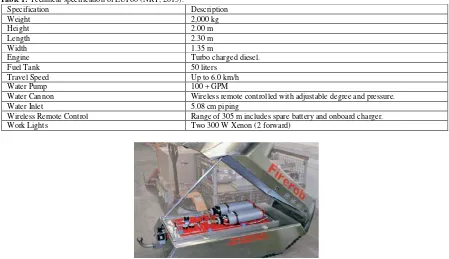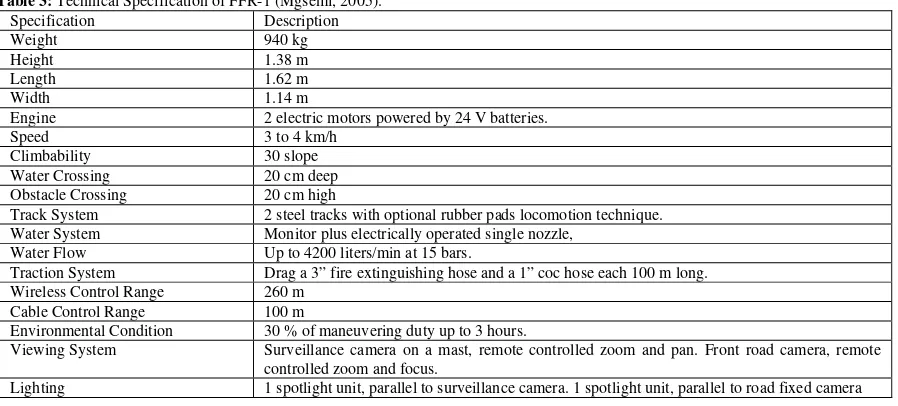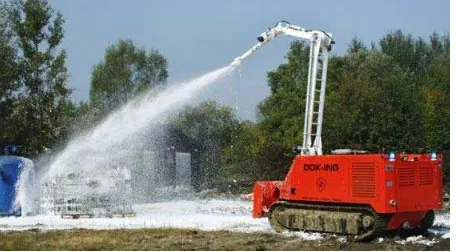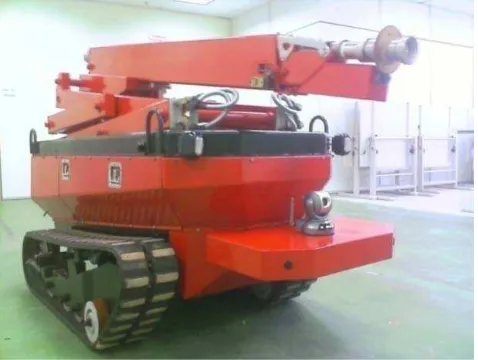Corresponding Author: Chee Fai Tan, Integrated Design Research Group (IDeA), Centre of Advanced Research on Energy (CARE), Faculty of Mechanical Engineering, Universiti Teknikal Malaysia Melaka, Melaka, Malaysia.
220
Fire Fighting Mobile Robot: State of the Art and Recent Development
1
Chee Fai Tan, 2S.M. Liew, 1M.R. Alkahari, 4S.S.S. Ranjit, 1M.R. Said, 3W. Chen, 3G.W.M. Rauterberg, 1D. Sivakumarand 4Sivarao
1
Integrated Design Research Group (IDeA), Centre of Advanced Research on Energy (CARE) Faculty of Mechanical Engineering, Universiti Teknikal Malaysia Melaka, Melaka, Malaysia.
2
RitzPower Mechanics Private Limited, Malaysia
3
Designed Intelligence Group, Department of Industrial Design, Eindhoven University of Technology, Eindhoven, the Netherlands
4
Faculty of Electronic and Computers Engineering, Universiti Teknikal Malaysia Melaka, Melaka, Malaysia.
5
Faculty of Manufacturing Engineering, Universiti Teknikal Malaysia Melaka, Melaka, Malaysia.
Abstract: The fire fighting is a risky work where the fire fighters need to face the fire hazards to save life and properties. Different equipments such as fire extinguisher, axes and cutting equipment are used to fight against fire. Fire fighting vehicle is being used to transport firefighters to the scene as well as transport the fire fighting equipments. The fire fighter is still facing the risk of fire hazard because they still need to go near to fire scene. To reduce the fire fighter risk during fire incident, a fire fighting mobile robot is designed. Fire fighting mobile robot is a remote controlled machine that replace fire fighter to perform fire fighting task. The application of fire fighting mobile robot is able to reduce the direct contact of fire fighter to the fire hazards. The paper reviews a variety of technologies and state-of-the-art technology of fire fighting mobile robot. The paper also describes the first Malaysian designed and built fire fighting mobile robot, namely, MyBOT2000.
Key words: Fire fighting, mobile robot.
INTRODUCTION
Fire fighting is risky profession. They are not only extinguishing fires in tall buildings but also must drag heavy hoses, climb high ladders and carry people from buildings and other situations. There are many fire fighters lost their lives in the line of duty each year throughout the world. The statistics of the fire fighter fatalities are still maintain at high level every year and it may continue to increase if there is no improvement in fire fighting techniques and technology. In addition to working in long and irregular hours and unfriendly working environment such as high temperature, dusty and low humidity, firefighters are also facing with potentially life threatening situation such as explosion, collapsed building and radioactive. The common equipment used by firefighters such as flat head axe, halligan bar, turnout jacket, fire retardant or bunker pants, boots, flashlight, helmet, face mask, and gloves do not significantly reduce risk on their lives when facing those life threatening situations.
IAFF (2000) reported that there are 1.9 firefighters are killed per year in the USA, per 100,000 structure fires. However, this rate was increasing to 3.0 per 100,000 structure fires across a thirty year period which is peaking in the 1990s (Kyle, 2007). There are many causes for Line of Duty Deaths (LODD) such as smoke inhalation, burns, crushing injuries and related trauma (Rosmuller and Ale, 2008). The death of on duty fire fighter in US during 1977-2010 year is shown in the statistic in Figure 1. From the statistic, it shows that the death of the fire fighter almost constant every year. Therefore, there is a need of fire fighting machine in assisting the fire fighter to avoid death by handling some dangerous situations.
221
Fig. 1: On duty Fire Fighter Fatalities 1977-2010. (Photo reprinted from Rita et al., 2011).
Current Fire Fighting Machine:
The rapid development in technology nowadays, directly improve the tools and equipment used in fire fighting. With these advance tools and equipment, fire fighting can be more effective and efficient. Besides, it also reduces the risk to minimum level. Moreover, the damages of fire incident can be reduced. Fire fighting mobile robot is one of the solution that able to reduce the fire hazards risk on fire fighter. Different type of current available fire fighting machine will be described.
LUF60:
LUF60 (Figure 1) is a diesel powered mobile fire fighting machine is equipped with air blower and a water beam fog. The machine is able to clear the hazardous obstacles by blowing the mixture of air and water. Besides, the machine is designed to withstand the rigor operating conditions and confined spaces. The LUF60 can be used in rail tunnels, aircraft hangers, parking garages, chemical plant, etc. There are some significant features of this machine. The monitor nozzle has a flow rate up to 800 GPM and it can blow the water beam as far as 80m. In order to enhance it mobility in high temperature condition, it is equipped with rubber track system which is rated to 400 degrees Fahrenheit. The rubber track system enables the robot tWo climb the stair. Besides, this machine able to operate on slopes of maximum 20 degrees with the ventilation tube at a maximum 45 degree angle (NRT, 2013). The technical specification of MVF-5 is shown in Table 1.
Fig, 1: LUF60.
(Photo reprinted from NRT, 2013)
FIREROB:
222
Table 1: Technical specification of LUF60 (NRT, 2013).
Specification Description
Weight 2,000 kg
Height 2.00 m
Length 2.30 m
Width 1.35 m
Engine Turbo charged diesel.
Fuel Tank 50 liters
Travel Speed Up to 6.0 km/h
Water Pump 100 + GPM
Water Cannon Wireless remote controlled with adjustable degree and pressure.
Water Inlet 5.08 cm piping
Wireless Remote Control Range of 305 m includes spare battery and onboard charger.
Work Lights Two 300 W Xenon (2 forward)
Fig. 2: Service Robot FIREROB (Photo reprinted from Americancrane, 2009).
Table 2: Technical Specification of FIREROB (Americancrane, 2009).
Specification Description Without Heat Shield Description With Heat Shield
Weight 250 kg 360 kg
Height 0.385 m 0.815 m
Length 1.30 m 1.60 m
Width 0.685 m 0.720 m
Speed 3 km/h 3 km/h
Smallest Turning Radius 1.46 m 1.70 m
Climbing Ability On Stair 32° 32°
Ground Clearance 0.12 m 0.12 m
FFR-1:
FFR-1 (Figure 3) is a fire fighting robot that used to enable firefighters to carry out difficult missions. The FFR-1 is a remote controlled double-tracked robot that carry monitor and used to extinguish fire. The robot is designed to operate under hazardous environment conditions as high temperatures, poisonous materials and inside unsafe buildings.
Fig. 3: FFR-1 Fire Fighting and Rescue Wireless Robot (bowen39, 2012).
Operating FFR-1 enables firefighters to execute missions in confined spaces, narrow streets, industrial buildings, stores, tunnels, airports, military installations, power plants, chemical plants and others. FFR-1 is easily transported on a modified vehicle or a trailer, imparting an operational advantage for firefighters at early stage of the fire as well as during the whole operation. The FFR-1 has a internal double-walled cooling system to avoid the overheating cause by high external temperature. FFR-1 is a highly maneuverable robot with cross-country capabilities. It runs on treads and can climb up to 30 degree incline dragging a 3 inch fire hose (Mgsemi, 2005). The technical specification of FFR-1 is shown in Table 3.
223
Table 3: Technical Specification of FFR-1 (Mgsemi, 2005).
Specification Description
Weight 940 kg
Height 1.38 m
Length 1.62 m
Width 1.14 m
Engine 2 electric motors powered by 24 V batteries.
Speed 3 to 4 km/h
Climbability 30 slope
Water Crossing 20 cm deep
Obstacle Crossing 20 cm high
Track System 2 steel tracks with optional rubber pads locomotion technique.
Water System Monitor plus electrically operated single nozzle,
Water Flow Up to 4200 liters/min at 15 bars.
Traction System Drag a 3” fire extinguishing hose and a 1” coc hose each 100 m long.
Wireless Control Range 260 m
Cable Control Range 100 m
Environmental Condition 30 % of maneuvering duty up to 3 hours.
Viewing System Surveillance camera on a mast, remote controlled zoom and pan. Front road camera, remote
controlled zoom and focus.
Lighting 1 spotlight unit, parallel to surveillance camera. 1 spotlight unit, parallel to road fixed camera
FIREMOTE 4800:
The Firemote 4800 illustrated in Figure 4 is an Unmanned Ground Vehicle. It is equipped with a fire-fighting nozzle, high pressure water equipment, spray nozzle, navigation cameras, thermal imaging camera, cooling system and roll-flat hose inlet. All the equipment is contained in a stainless steel insulated body which can reflect radiant heat. It can also protect tracks and sensitive parts by circulating water through chassis and using fixed nozzle to cool down the body. The Firemote 4800 is controlled from a panel by the help of color cameras consisted of 2 forward facing and 2 rearward facing, angled to give wide field of view. The panel uses a trans-reflective monitor that shows a software dashboard with the Firemote 4800’s parameters and images from the 4 cameras simultaneously for ease of navigation. The command centre can receive video from the panel as it has an inbuilt computer that can record or send on video files. The technical specification of FIREMOTE 4800 is shown in Table 4.
Fig. 4: Firemote 4800.
(Photo reprinted from Ryland Research Limited Company, 2011)
Table 4: Technical Specification of Firemote 4800 (Ryland Research Limited Company, 2011).
Specification Description
Weight 450 kg
Height 1.14 m
Length 1.40 m
Width 0.70 m
Body 304 Grade Polished Stainless Steel with internal insulation.
Power Sources 36 Volt 65AH gel lead acid batteries or DC power via umbilical cable from 24V
vehicle supply.
Speed Up to 4.5 km/h
Water Cannon Up to 1700 liters/min of water at 7 bar (100psi)
Track System Steel reinforced rubber tracks
Traction Sufficient to pull at least 200 meters of empty hose.
Cooling/Protection Fixed nozzles to produce fog shield and to cool body and tracks by soaking.
Wireless Communication Standard 802.11n Wi-Fi for video and 2.4 GHz spread spectrum radio modem for
control.
224 MVF-5:
The MVF-5 as shown in Figure 5 is a multifunctional robotic fire fighting machine manufactured by Croatian manufacturer DOK-ING, to put out fires in unreachable areas and life threatening conditions. It is a fire fighting vehicle that operated by a single operator and controlled by using remote control. With the remote-control technology GPS-INS (Global Position System- Inertial Navigation System), the system is able to be controlled in the range of 1500m.
Fig. 5: MVF-5 Autonomous Fire Fighting Machine. (Photo reprinted from DOK-ING Company, 2010)
The MVF-5 helps to assist the firefighters to secure high risk infrastructure. It also extinguishes fires without intervention of firefighters with high-pressure cannon on a hydraulic arm that pumps water up to 55 m away. The MVF-5 has a high-temperature-resistant fire protection shield. The protection shield is based on reflective in tumescent materials that bubble, expand in volume, and become denser when exposed to fire. DOK-ING Company claimed that the multilayer coatings on MVF-5 are able to withstand 700 C for 15 minutes or 400 C for 30 minutes, making it suitable for high-temperature areas. The MVF-5 can spray 2000 liters of water or foam per minute. The tank capacity is 2200 liters of water and 500 liters of foam. The high pressure cannon which is fitted on the specially designed 3-level hydraulic arm has 360° rotation. This enables high pressure cannon delivering of the extinguishing liquids in all desired directions (DOK-ING Company, 2010). The technical specification of MVF-5 is shown in Table 5.
Table 5: Technical Specification of MVF-5 (DOK-ING Company, 2010).
Specification Description
Weight 9274 kg
Height 2109 mm
Length 3800 mm
Width 2180 mm
Body NA
Power Sources 6-cylinder, in-line, turbo-charged diesel
Speed 12 km/h
Water Cannon 2000 l/min
Track System NA
Traction Steel reinforced rubber tracks
Wireless Communication Remote controlled
Wireless System Range Up to 1500m
JMX-LT50:
225
Fig. 6: JMX LT50 (Photo reprinted from Chinawe, 2013).
Table 6: Technical Specification of JMX-LT50 (Chinawe, 2013).
Specification Description
Weight 1500 kg
Height 1560 mm
Length 2400 mm
Width 1435 mm
Body NA
Power Sources NA
Speed 12 km/h
Water Cannon 50 liter/sec
Track System NA
Traction Wheel tire
Wireless Communication Remote controlled
Wireless System Range Up to 150m
SACI 2.0:
The Brazilian made water-blasting robot named SACI (Figure 7) was introduced in 2006. SACI is able to put off the fire by directing the water stream, foam blast or a fog blowing technique. The machine When extinguishing fire, this machine will produce a maximum blast of 60 meters, and the cannon pivots from 20 - 70 degrees vertically while being wheeled around on the tank-like track system. It can have water cannons capable to have a water flow up to 7,600 liters per minute. There are two Foam Generator Liquid reservoirs with 25 liters capacity each build internally (ARMTEC, 2013).
Fig. 7: SACI 2.0 (Photo reprinted from ARMTEC, 2013).
226
Table 7: Technical Specification of SACI 2.0 (ARMTEC, 2013).
Specification Description
Weight NA
Height 1600 mm
Length 1800 mm
Width 1500 mm
Body NA
Power Sources Battery
Speed 12 km/h
Water Cannon 8400 l/min
Track System NA
Traction Steel reinforced rubber tracks
ArchiBot-M:
The Korean designed firefighting robot, namely, ArchiBot-M (Figure 8) is the mobile robot that used in the human inaccessible location. It is used for on-site checking and clears the path for fire fighter. The robot was equipped with an special designed independent suspension system for stair climbing and working in high temperature. The robot also is designed with waterproof ability and equipped with a cooling system in order the robot to be worked in the hot environment. The technical specification of ArchiBot-M is shown in Table 9.
Fig. 8: ArchiBot-M (Photo reprinted from Drbfatec, 2013).
Table 8: Technical Specification of SACI 2.0 (Drbfatec, 2013).
Specification Description
Weight 450 kg
Height 650 mm
Length 1400 mm
Width 800 mm
Body NA
Power Sources NA
Speed 20 km/h
Water Cannon NA
Track System NA
Traction Steel reinforced rubber tracks
Thermite T2:
227
Fig. 8: Thermite T2 (Photo reprinted from Howeandhowe, 2013).
Table 9: Technical Specification of Thermite T2 (Howeandhowe, 2013).
Specification Description
Weight 744 kg
Height 1397 mm
Length 1880 mm
Width 889 mm
Body A440f steel, aircraft 5 grade aluminium
Power Sources Engine
Speed 20 km/h
Water Cannon 600 GPM with multi-directional nozzle
Track System NA
Traction NA
MyBOT2000:
The developed of MyBOT2000 (Tan et al., 2012a; Tan et al., 2012b; Tan et al., 2013) is a remotely controlled machine consists of a mobile and rigid chassis. The robot is designed and developed in Malaysia. The different view of MyBot2000 is showed in Figure 9 and Figure 10. The machine is wirelessly controlled via mobile computer. The nozzle of the machine can be directed at different angle and can be elevated in order to control fire at different height. One of the great importance of the development of the Fire Fighting Machine is it can reduce the risks faced by fire fighters in performing their duties. This is due to the fact to the current fire fighting techniques require fire fighters to intervene in hazardous conditions. Working at high temperature, dusty, low humidity, dangerous and others are among usual working conditions associated with fire fighting. The MyBot2000 system is a ground vehicle that was equipped with long-range control and monitoring ability for firefighting and rescue purpose. The MyBot2000 is capable of fire fighting and searching purpose in a hazardoud environment. In addition, the MyBot2000 is using green energy, which is electric, to power the machine. The current MyBot2000 will be equipped with state of the art sensor and imaging system to detect and locate fire victim. The first generation of MyBot2000 was developed in the year 2006. Currently, the 4th generation of MyBot2000 is under development process. The new design of the MyBot2000 will equipped with better track system, lighter structure, controllable multi-directional water cannon, long range wireless CCTV, common platform as well as long range control capability. The common based of MyBot2000 will be built as well in order the MyBot2000can be used for different purposed. The technical specification of MyBot2000 is shown in Table 8.
Table 10: General specifications of the MyBOT2000.
Specification Description
Weight 910 kg
Height 1300 mm
Length 1500 mm
Width 1000 mm
Body Mild steel
Power Sources Battery
Speed 2.36 km/h
Water Cannon Single water nozzle
Track System Heavy duty rubber track belt
Traction NA
Comparison of Current Fire Fighting Mobile Robot:
228
Fig. 9: Side View of MyBOT2000.
Fig. 10: MyBOT2000.
Table 9: The comparison of current fire fighting mobile robot. Specificatio
SACI ArchiBot Thermite FFM3000
Size
Battery Battery Diesel
229 Summary:
Different technical specification of 10 current fire fighting mobile robots was compared in Table 9. As referred to Table 9, MVF5 is the biggest and heaviest fire fighting robot among others. The MVF5 is to be operated at outdoor only and it is not able to enter certain architecture. It is follows by LUF60 and JMX-LT50. MVF5, LUF60 and JMX-LT50 were designed to withstand loads, equipped with bigger water cannon and it is able to control fire in a short time. The MVF5 robot was equipped with elevated water cannon and a built in water tank. The JMX-LT50was equipped with remote controlled water cannon. For LUF60, it is equipped with a powerful ventilator to blow the high volume of water in the form of water fog. Next, the weight of remain seven mobile robots are less than 1000kg. Most of the mobile robot such as Firerob, FFR-1, Firemote-4800, SACI, ArchiBot and MyBOT2000 are using battery as power source, except Thermite is using diesel engine. In general, 90% of the mobile robots are using water nozzle, 80% of the mobile robots are using remote control water cannon, and less than 20% of the mobile robots are carrying water tank. The application of the developed fire fighting mobile robot is to be used in the petrochemical plants, hazardous area such as radioactive environment, unstable structure, and high pressure vessel. Currently, the development of the fire fighting mobile robot still not fully supported by local authority or fire department to be implemented during critical scene and reduce the risk fire fighter. Efforts need to be made to encourage the use of fire fighting mobile robot by designing a low cost and good quality machine.
ACKNOWLEDGMENT
The authors / researchers are very much in-debt to thank the Ministry of Higher Education Malaysia (MOHE) for awarding a research grant (PRGS/2012/TK01/FKM/02/1/T0004) which enabled the progressing of this critical research. Special thanks to the top level management of Universiti Teknikal Malaysia Melaka (UTeM), including Centre for Research and Innovation Management (CRIM) and Faculty of Mechanical Engineering administrators.
REFERENCES
Amano, H., 2000. Present Status and Problems of Fire Fighting Robots. SICE 2002. Proceedings of the 41st SICE Annual Conference, 2: 880- 885.
Americancrane. http://www.americancrane.com/Telerob/Firerob.htm. Accessed on 8 Mar 2013. Anna Konda – The Fire Fighting Snake Robot. Armtec. http://v2.armtecbrasil.com/index.php?produto=2. Accessed on 8 Mar 2013.
Chinawe. http://www.chinawe.net/html/xf/thxf/20100609_268016.html. Accessed on 8 Mar 2013. DOK-ING. Firefighting (MVF-5). http://www.dok-ing.us/products.html. Accessed on 5 October 2011. Drbfatec. http://www.drbfatec.com/frd_center/fighting_m.htm. Accessed on 8 Mar 2013.
Hisanori, A., 2002. Present Status and Problems of Fire Fighting Robots. SICE 2002. Proceedings of the 41st SICE Annual Conference, 2: 880- 885.
HKFSD. Mobile Fire Fighting Supporting Machine LUF 60R. http://www.hkfsd.gov.hk/home/images/ equipment/fire/e_luf60.html. Accessed on 13th September 2008.
Howe and Howe. http://www.howeandhowe.com/uploads/1/5/2/4/15246154/rs1-t2_quad_chart.pdf. Accessed on 8 Mar 2013.
International Association of Fire Fighters (IAFF), 2000. Death and Injury Survey, Washington.
Kyle, S.N., 2007. NFPA Releases Firefighter Death Study, U.S.A.
http://cms.firehouse.com/content/section/news. Accessed on 5 September 2008.
NEVA. Mobile Fire Fighting Robot. Russia 13th September 2008.
Mgsemi. http://mgsemi.com/hewsales/ffr-1.html. Accessed on 8 Mar 2013.
NRT. http://www.nrt.org/production/NRT/RRT3.nsf/Resources/May2009ppt2/$File/LUF-60_Presentation_to_ Chiefs-2.pdf. Accessed on 8 Mar 2013.
Rita, F., P.R.L, Fahy and J.L. Molis, 2011. Firefighter Fatalities in the United States-2010. National Fire Protection Association, Fire Analysis and Research Division.
Rosmuller, N. and B.J.M. Ale, 2008. “Classification of fatal firefighter accidents in the Netherlands: Time pressure and aim of the suppression activity,” Journal of Safety Science, 46: 282-290.
Ryland Research Limited, 2001. “Firemote 4,800” Bordon, (U.K.): Trade Brochure.
Sofge, E., 2007. First Firefighting Robots Deployed, Could Spark Autonomous Dept. Las Vegas.
Tan, C.F., S.S.S. Ranjit and S.A. Anas, 2012a. Water Pressure Loss Analysis of Mobile Machine for Fire Fighting Purpose. International Journal of Soft Computing and Engineering, 1(6): 437-440.
230
Tan, C.F., E.S. Ng and A.T. Din, 2012c. Mechanical Design and Analysis of All-terrain Mobile Robot. Jurnal Teknologi, 58: 21-25.
